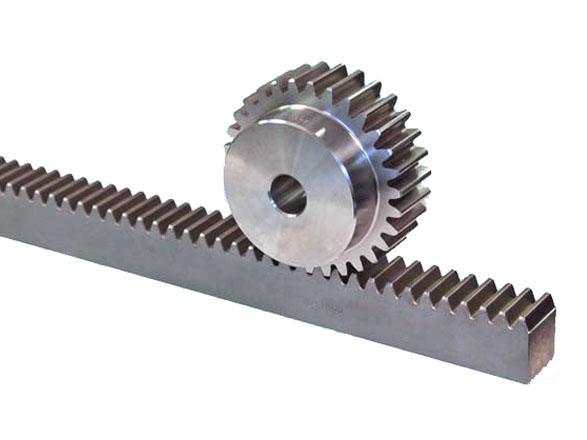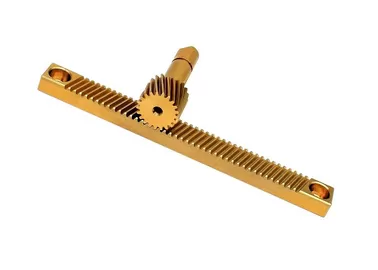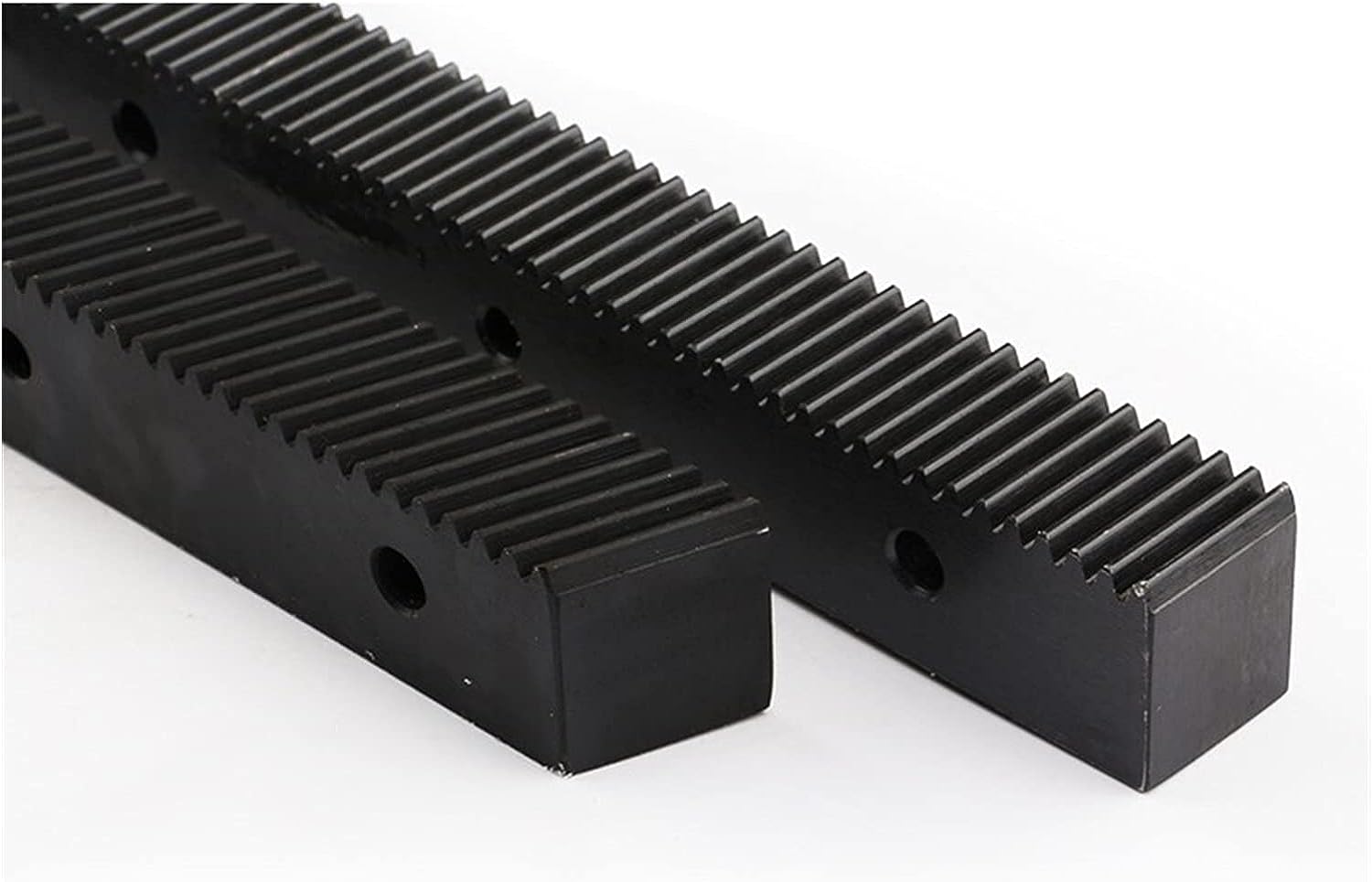Product Description
Product Description
|
Products |
Gear rack |
|||
|
Precision grade |
DIN5, DIN6, DIN7, DIN8, DIN10 |
|||
|
Material |
C45 steel, 304SS, 316SS, 40CrMo, nylon, POM |
|||
|
Heat treatment |
High frequency,Quenching/Carburization, Teeth hardened |
|||
|
Surface treatment |
Zinc-plated,Nickle-plated,Chrome-plated,Black oxide or as you need |
|||
|
Application Machine |
Precision cutting machines. Lathes machine Milling machines Grinders machine Automated mechanical systems Automated warehousing systems. |
|||
|
Produce Machine |
CNC engine lathe CNC milling machine CNC drilling machine CNC grinding machine CNC cutting machines Machining center |
|||
|
Workstyle |
Execution is more preferred than empty talk. |
|||
|
Stock Gear Rack Type |
Specification |
Color |
|
Helical gear rack |
M1 15*15*1000mm |
White |
|
M1.5 19*19*1000mm |
White |
|
|
M2 24*24*1000mm |
White |
|
|
M3 29*29*1000mm |
White |
|
|
M4 39x39x1000mm |
White |
|
|
Spur gear rak |
M1 15*15*1000mm |
Black |
Rack Assembly
To assemble connected racks more smoothly, 2 ends of a standard rack would add half tooth which is convenient for next half tooth of next rack to be connected to a complete tooth. The following drawing shows how 2 racks connect and tooth gauge can control pitch position accurately.
With regards to connection of helical racks, it can be connected accurately by opposite tooth gauge.
1. When connecting racks, we recommend lock bores on the sides of rack first, and lock bores by the sequence of the foundation. With assembling the tooth gauge, pitch position of racks can be assembled accurately and completely.
2. Last, lock the position pins on 2 sides of rack; the assembly is completed.
Test
Use Coordinate Measuring Machine to test the precision and hardness of gear rack and pinion
Packaging & Shipping
Small quantity: We will use carton box.
Big quantity: We will use wooden cases.
Company Profile
ZheJiang Haorongshengye Electrical Equipment Co., Ltd.
1. Was founded in 2008
2. Our Principle:
“Credibility Supremacy, and Customer First”
3. Our Promise:
“High quality products, and Excellent Service”
4. Our Value:
“Being Honesty, Doing the Best, and Long-lasting Development”
5. Our Aim:
“Develop to be a leader in the power transmission parts industry in the world”
|
6.Our services: |
1).Competitive price |
|||
|
2).High quality products |
||||
|
3).OEM service or can customized according to your drawings |
||||
|
4).Reply your inquiry in 24 hours |
||||
|
5).Professional technical team 24 hours online service |
||||
|
6).Provide sample service |
||||
Main products
Machines
Exbihition
| Application: | Machinery |
|---|---|
| Hardness: | Hardened Tooth Surface |
| Gear Position: | Internal Gear |
| Manufacturing Method: | Hobbing |
| Toothed Portion Shape: | Spur Gear |
| Material: | Steel |
| Samples: |
US$ 200/Piece
1 Piece(Min.Order) | |
|---|
| Customization: |
Available
| Customized Request |
|---|

How do helical gear racks handle different gear ratios and helix angles?
Helical gear racks are designed to handle different gear ratios and helix angles, providing flexibility in power transmission systems. The gear ratio determines the speed and torque conversion between the driving and driven gears, while the helix angle influences the smoothness of engagement and the load distribution across the gear teeth. Here’s a detailed explanation of how helical gear racks handle these parameters:
- Gear Ratios: Helical gear racks can accommodate different gear ratios by pairing them with helical gears of corresponding ratios. The gear ratio is determined by the number of teeth on the driving and driven gears. By selecting helical gears with different numbers of teeth, the gear ratio can be adjusted to achieve the desired speed and torque conversion. Helical gear racks provide a linear motion that engages with the helical gear, allowing for precise and efficient power transmission across a wide range of gear ratios.
- Helix Angles: The helix angle is the angle at which the gear teeth are inclined relative to the gear axis. Helical gear racks are designed with a corresponding helix angle that matches the helix angle of the mating helical gear. The helix angle affects the smoothness of engagement and the load distribution across the gear teeth. A larger helix angle results in a smoother and quieter operation, as it facilitates gradual tooth contact during meshing. It also helps distribute the load across multiple teeth, reducing the stress on individual teeth and promoting higher load-carrying capacity.
When handling different gear ratios and helix angles, it’s important to consider the following factors:
- Tooth Contact: As the gear ratio and helix angle change, the contact pattern between the helical gear and gear rack may shift. Proper tooth contact is crucial for efficient power transmission and to avoid excessive wear or noise. It’s essential to ensure that the gear rack and helical gear are properly aligned and adjusted to achieve the desired tooth contact pattern.
- Lubrication: Adequate lubrication is vital to reduce friction and wear between the gear teeth. The presence of a helix angle introduces sliding motion between the helical gear and gear rack during engagement. Proper lubrication helps minimize frictional losses and ensures smooth operation even at higher helix angles or gear ratios.
- Load Distribution: The helix angle and gear ratio affect the load distribution across the gear teeth. Higher helix angles and gear ratios can distribute the load more evenly, reducing the stress on individual teeth and promoting higher load-carrying capacity. This is particularly advantageous in applications with high torque or heavy loads.
It’s important to note that as the gear ratio increases or the helix angle becomes steeper, the axial forces on the gear rack also increase. Adequate support and proper mounting arrangements are necessary to handle these axial forces and ensure the gear rack remains stable and properly engaged with the helical gear.
In summary, helical gear racks handle different gear ratios and helix angles by providing a linear motion that engages with helical gears of corresponding ratios and angles. Through proper tooth contact, lubrication, and load distribution, helical gear racks enable efficient power transmission and smooth operation across a wide range of gear ratios and helix angles in various applications.

Can helical gear racks be used for both rotary and linear motion?
Yes, helical gear racks can be used for both rotary and linear motion applications. They are versatile components that convert rotational motion into linear motion or vice versa, depending on their configuration and usage. Here’s a detailed explanation:
For Rotary-to-Linear Motion:
- When a helical gear engages with a helical gear rack, the rotational motion of the gear is converted into linear motion along the gear rack’s length. As the helical gear rotates, the inclined teeth of the gear mesh with the teeth of the gear rack, causing the rack to move in a linear direction. This linear motion can be used to drive various mechanisms or systems that require linear motion, such as sliding doors, CNC machines, or positioning systems.
- By adjusting the gear ratio and helix angle, the speed and precision of the linear motion can be controlled. Higher gear ratios result in faster linear motion, while smaller helix angles provide smoother engagement and reduce the risk of backlash.
For Linear-to-Rotary Motion:
- Helical gear racks can also be used to convert linear motion into rotary motion. In this configuration, the gear rack is driven by a linear actuator or another mechanism, causing the rack to move linearly. As the rack moves, it engages with a helical gear, which translates the linear motion into rotational motion.
- This setup is commonly used in applications such as rotary indexing tables, where precise and controlled rotary motion is required based on the linear input provided by the gear rack.
It’s important to consider certain factors when using helical gear racks for rotary or linear motion:
- Precision: The precision of the motion depends on the gear rack’s manufacturing quality, gear engagement, and overall system design. Proper alignment, tooth contact, and lubrication are crucial to achieving smooth and accurate motion.
- Load Capacity: The load capacity of a helical gear rack should be considered to ensure it can handle the forces involved in the application. Factors such as the material, tooth profile, and dimensions of the gear rack impact its load-carrying capabilities.
- Backlash: Backlash refers to the clearance or lost motion between the gear teeth when changing direction. Minimizing backlash is important to maintain precision and avoid unwanted play or oscillation in the motion. Proper gear design, high-quality manufacturing, and appropriate adjustments can help reduce backlash.
In summary, helical gear racks can be used for both rotary and linear motion applications. They convert rotational motion into linear motion or vice versa, offering versatility in various mechanical systems. Whether used for rotary-to-linear or linear-to-rotary motion, proper design, alignment, lubrication, and consideration of load capacity and backlash are essential for achieving optimal performance and precision.

What advantages do helical gear racks offer for precise linear motion?
Helical gear racks offer several advantages for achieving precise linear motion in various applications. Here’s a detailed explanation of the advantages provided by helical gear racks:
- Smooth Operation: Helical gear racks provide smoother operation compared to straight gear racks. The helical design of the teeth allows for gradual and continuous engagement between the rack and the mating gear. This results in reduced noise, vibration, and backlash, contributing to smoother linear motion.
- Improved Load Distribution: The helical tooth design of gear racks helps distribute the load more evenly along the teeth and across the rack. This improves the load-carrying capacity and reduces concentrated stresses on specific teeth. The improved load distribution results in enhanced durability and reliability of the gear rack system.
- Higher Torque Capacity: Helical gear racks have a higher torque capacity compared to straight gear racks. The helical teeth provide greater tooth engagement, resulting in increased contact area and improved power transmission efficiency. This allows helical gear racks to handle higher torque loads, making them suitable for applications that require high force or heavy-duty operation.
- Reduced Backlash: Backlash refers to the clearance or play between the teeth of a gear system. Helical gear racks have inherent backlash reduction due to their helical tooth design. The gradual engagement of helical teeth minimizes the gap between teeth, resulting in reduced backlash. This is particularly beneficial for applications that require precise positioning and accurate motion control.
- High Positioning Accuracy: Helical gear racks offer high positioning accuracy, making them suitable for applications that require precise linear motion control. The helical tooth design, combined with low backlash and smooth operation, allows for accurate and repeatable positioning of the rack. This is essential in industries such as CNC machining, robotics, and automation systems.
- Reduced Wear: The helical tooth engagement in gear racks helps distribute the wear more evenly along the teeth. This results in reduced localized wear and prolongs the lifespan of the gear rack system. The improved load distribution and reduced friction contribute to lower wear rates, making helical gear racks more durable and reliable.
- Noise Reduction: Helical gear racks generate less noise compared to straight gear racks. The helical tooth engagement spreads the contact forces over a larger area, reducing noise and vibration during operation. This is advantageous in applications where noise reduction is desired, such as in printing machinery, medical equipment, and precision instruments.
In summary, helical gear racks offer advantages such as smooth operation, improved load distribution, higher torque capacity, reduced backlash, high positioning accuracy, reduced wear, and noise reduction. These advantages make helical gear racks well-suited for applications that require precise linear motion control, accurate positioning, and reliable power transmission.


editor by CX 2023-10-26